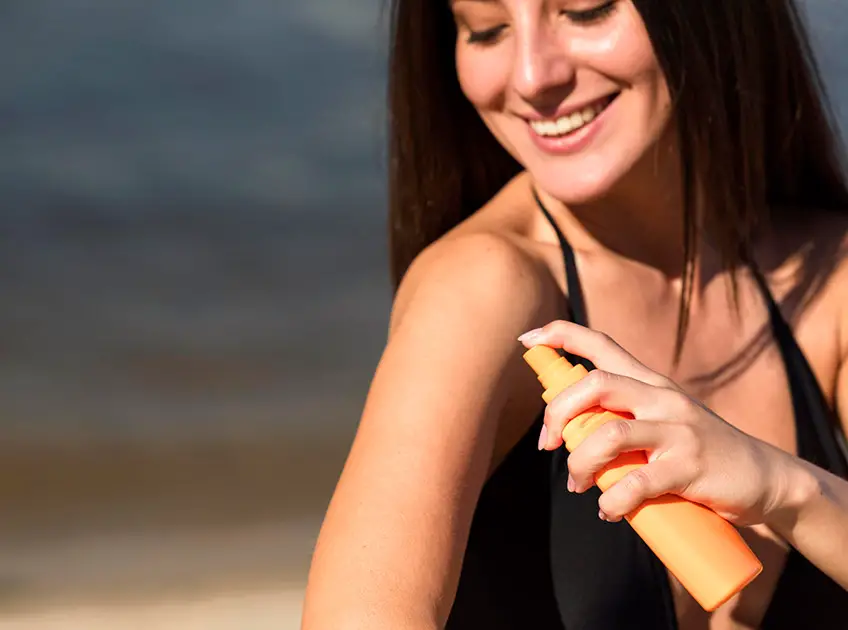
Important: This article is for informational purposes only. Please read our full disclaimer for more details.
Sun is the biggest blessing in disguise. Even though we hate it for some reason, we can’t afford to live without it.
However, when it comes to skin, we used to have a love-hate relationship with the sun. While it helps to absorb Vitamin D and tan the skin, excessive exposure can cause skin damage.
If you like getting tanned but worry about skin damage and sunburn, a self-tanner is the best option to get the sun-kissed glow. Self-tanners are considered the best alternative to suntan but are they really safe?
This article will help you learn whether ‘is self-tanner bad for you and, if it is, how it may harm the skin and what are the ways to prevent it.
How Does Self-tanner Work?
To know if a self-tanner is a good alternative, it is essential to learn how it works. So, let’s talk about the mechanism behind self-tanners and how they help to darken the skin.
The active ingredient in self-tanners is DHA- dihydroxyacetone, a simple carbohydrate. As you apply a self-tanner or spray tanner on the skin, it spreads on the uppermost layer of the dermis and reacts with the amino acids.
The reaction of DHA with amino acids generates melanoidins. As melanoidins increase, the skin starts darkening, leading to the development of golden bronze skin tone. It looks similar to the tan developed by the skin as a response to increased melanin content, thus imitating suntan.
This process is called the Maillard reaction and usually starts after 2-4 hours of self-tanner application. The process may continue for up to 72 hours; therefore, you need to be really patient to get the desired skin tone.
Most self-tanners claim to keep your skin tanned for ten days; however, the result varies depending upon various factors like how well you have prepared your skin before applying self-tanner and how well you follow the aftercare instructions.
As you apply self-tanner, you may come across a distinctive odor, a telltale sign indicating the chemical reactions happening in the skin. Many brands put artificial fragrances to mask this distinctive odor.
How Safe Is Self-tanner For Skin?
As we learn about the chemical reaction, wondering if it is safe for the skin or not is obvious. Here, it is important to know that this Maillard reaction occurs every time you bring your skin near the flame, for instance, while cooking and roasting.
So, a self-tanner is somewhat similar to roasting the skin. Here’s what happens as a result of Maillard’s reaction-
1. Free Radicals Generate
As a response to Maillard’s reaction by self-tanners, free radicals are generated on the skin. Free radicals are the culprits behind premature aging as they degrade collagen and elastin fibers and cause wrinkles and fine lines.
This premature aging worsens if you step outside without sun protection, especially after applying self-tanner. More free radicals will start producing as UV rays will make DHA unstable.
2. Induces Skin Aging And Damages DNA
As DHA generates free radicals, skin experiences oxidative stress that works to accelerate skin aging. All this leads to blemishes, fine lines, wrinkles, uneven skin tone, and aging spots.
At the same time, studies have confirmed that DHA promotes cell death and also damages DNA. It has led people to question its long-term safety.
3. Reduces Vitamin D production
Studies have revealed that regular use of self-tanner can lower the body’s ability to produce Vitamin D. Melanoidin pigments created by the DHA inhibited the formation of vitamin D.
It could pose serious health issues as Vitamin D is an essential component needed to keep the bones, muscles, and teeth healthy.
4. Causes Skin Irritation
Regular use of self-tanner can cause skin irritation, especially among people with sensitive skin. It can cause severe dermatitis on certain skin types. Moreover, the presence of artificial fragrances in self-tanners to mask their typical odor can contribute to further skin reactions.
These are some of the major concerns regarding self-tanners. They are equally applicable to spray tanners as they also contain DHA as the active ingredient. Spray tanners, in fact, are more notorious as using them involves the risk of inhaling the mist that may enter the respiratory system and promote the chances of certain cancers.
So now that we know self-tanners can affect the skin in different ways, what are the alternatives?
The best alternative to self-tanners is using a DHA-free self-tanner.
DHA-free Self-tanner
DHA-free self-tanner is a safer option than chemical-based self-tanners. They are gentler on the skin and deliver a gradual glow.
You can find some companies offering organic or DHA-free self-tanners that comprise a purified keto-sugar that reacts with skin amino acids to produce a golden tone. The companies claim that their DHA-free self-tanners produce a golden bronze glow within two to three days without the sensory drawbacks and potential negative effects associated with DHA.
Apart from using DHA-free self-tanners, you can also go for DIY self-tanners that similarly stain and darken the skin tone.
Final Words
Even though tanning through a self-tanner is better than exposing skin to the sun, its side effects are also prominent.
The best way to keep skin safe is to get tanned occasionally and wear skin-nourishing lotions and creams to upkeep the skin’s health after every tanning session.
You Might Also Like:
- Can You Still Get A Tan from Clouds?
- How to Tan with Fair Skin and Freckles
- Does Self Tanner Expire? What Happens If You Use It?
- 3 Natural DIY Self Tanner: That Doesn’t Wash Off
- 5 Best Self Tanner For Stretch Marks? How It Works
- 10 Best DHA Free Self Tanner
- 10 Best Self Tanner For Olive Skin
- How to Tan with Fair Skin and Freckles?
Image Credit: freepik















